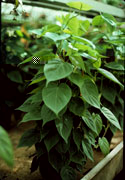


Home
Flowers &
Indoor Plants
Fruits & Nuts
Ornamentals
Vegetables
Special Topics
Resources
Glossary

Philodendron |
 |
What about it? Philodendrons are members of the Arum family, which makes them relatives of Dieffenbachia. Philodendrons are climbing, branching vines with alternating glossy leaves. The fiddle-leaf philodendron a.. biRennifolium) has large dark green leaves with 5 lobes. The velvet-leaf philodendron (P. scandens f. micans) has reddish and purplish leaves. What is it used for? Philodendrons are quite popular indoor plants and are often found in homes and public areas. The vining types will climb if they are provided with support. Where does it grow? How do we grow it? Philodendrons come from the tropics so they need warm temperatures. P. scandens does not need very much sunlight but P. bipennifolium does. Although they will tolerate dry soils, it is best to keep moist. What are its primary problems? Some species, especially P. selloum, are susceptible to bacterial leaf spot, mealybugs and red spider mites. Typically the only problem with philodendrons is that older plants tend to lose their lower leaves. If this is a problem the plants should be cut back to the base. How do we propagate it? Philodendrons propagate exceptionally well by cuttings. Either terminal, leaf petiole, or sectional cuttings are possible. Air layering is also an option.
© Copyright, Department of Horticulture, Cornell University. |
